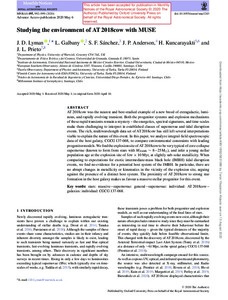Studying the environment of AT2018cow with MUSE
Lyman JD; Galbany L; Sanchez SF; Anderson JP; Kuncarayakti H; Prieto JL
Studying the environment of AT2018cow with MUSE
Lyman JD
Galbany L
Sanchez SF
Anderson JP
Kuncarayakti H
Prieto JL
OXFORD UNIV PRESS
Julkaisun pysyvä osoite on:
https://urn.fi/URN:NBN:fi-fe2021042826457
https://urn.fi/URN:NBN:fi-fe2021042826457
Tiivistelmä
AT 2018cow was the nearest and best-studied example of a new breed of extragalactic, luminous, and rapidly evolving transient. Both the progenitor systems and explosion mechanisms of these rapid transients remain a mystery - the energetics, spectral signatures, and time-scales make them challenging to interpret in established classes of supernovae and tidal disruption events. The rich, multiwavelength data set of AT 2018cow has still left several interpretations viable to explain the nature of this event. In this paper, we analyze integral-field spectroscopic data of the host galaxy, CGCG137-068, to compare environmental constraints with leading progenitor models. We find the explosion site of AT 2018cow to be very typical of core-collapse supernovae (known to form from stars with M-ZAMS similar to 8-25 M-circle dot), and infer a young stellar population age at the explosion site of few x 10 Myr, at slightly sub-solar metallicity. When comparing to expectations for exotic intermediate-mass black hole (IMBH) tidal disruption events, we find no evidence for a potential host system of the IMBH. In particular, there are no abrupt changes in metallicity or kinematics in the vicinity of the explosion site, arguing against the presence of a distinct host system. The proximity of AT 2018cow to strong star formation in the host galaxy makes us favour a massive stellar progenitor for this event.
Kokoelmat
- Rinnakkaistallenteet [27094]
